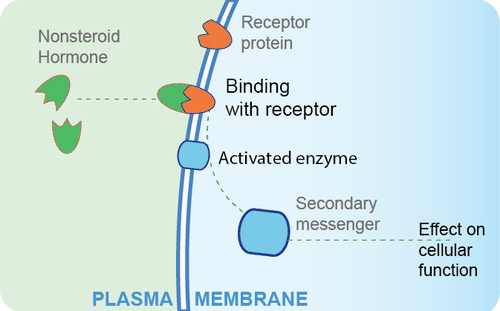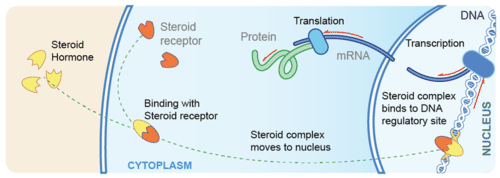荷角
Section outline
-
Steroid hormones . How do they work?
::类固醇荷尔蒙 它们怎么工作?As hormones, they are the messengers of the . Obviously, they must change something in the .
::作为荷尔蒙,他们是...Hormones
::荷角The body produces many different hormones, but each hormone is very specific to its target cells . A target cell is the cell on which a hormone has an effect. Target cells are affected by hormones because they have receptor proteins that are specific to the hormone. Hormones will travel through the bloodstream until they find a target cell with the specific receptors to which they can bind. When a hormone binds to a receptor, it causes a change within the cell.
::人体产生许多不同的荷尔蒙, 但每种荷尔蒙都是针对其目标细胞的。 目标细胞是荷尔蒙起作用的细胞。 目标细胞受到荷尔蒙的影响, 因为它们有荷尔蒙特有的受体蛋白。 荷尔蒙会穿透血液流, 直到他们找到目标细胞, 与特定受体结合。 当荷尔蒙与受体结合时, 它会在细胞内部造成变化 。There are two main types of hormones: amino acid and cholesterol based hormones (and a group of hormone-like substances).
::荷尔蒙主要有两种类型:氨基酸和胆固醇激素(和一组类似荷尔蒙的物质)。Amino Acid-Based Hormones
::氨酸激素Amino acid-based hormones are made of amino acids. Some amino acid-based hormones are made of a few amino acids and are simple in structure, while others are made of hundreds of amino acids and are very large. These hormones are not fat-soluble and therefore cannot diffuse through the plasma membrane of their target cell. They usually bind to receptors that are found on the .
::氨基酸激素是由氨基酸制成的,一些氨基酸激素是由几种氨基酸制成,结构简单,而其他的则由数百种氨基酸制成,并且非常大。这些激素不是脂肪溶性,因此不能通过目标细胞的血浆膜扩散。它们通常与在(......)中发现的受体捆绑。A non-steroid hormone binds with a receptor on the plasma membrane of a target cell. Then, a secondary messenger affects cell processes.
::非小类荷尔蒙与目标细胞血浆膜上的受体结合。然后,二级信使影响细胞过程。Cholesterol-Based Hormones
::基于胆酯醇的激素Cholesterol-based hormones are made of such as phospholipids and cholesterol. Hormones from this group are also called steroid hormones. Steroid hormones are fat soluble and are able to diffuse through the plasma membrane of a target cell. Steroid hormone receptors are found in the cell cytosol and .
::以胆固醇为基础的荷尔蒙由磷素和胆固醇等成分制成,该组的荷尔蒙也称为类固醇激素,类固醇激素是脂肪溶解的,能够通过目标细胞的血浆膜扩散,在细胞细胞细胞激素和细胞细胞细胞素中发现了类固醇激素受体。A steroid hormone crosses the plasma membrane of a target cell and binds with a receptor inside the cell.
::类固醇荷尔蒙穿过目标细胞的等离子膜,与细胞内的受体捆绑。Hormone-like Substances
::类似 ormonone 的物质The term hormone-like substances refers to a group of signaling molecules that are derived from certain types of fatty acids and . Two examples of these substances are prostaglandins and neuropeptides. These substances do not travel around the body in , as hormones do, and they tend to be broken down quickly. As a result, the effects of hormone-like substances are localized to the tissue in which it they are produced. For example, prostaglandins, which are made from essential fatty acids , are produced by most cells in the body. Prostaglandins have many different effects, such as causing constriction or dilation of , but they are all localized within the target cells and tissues. Neuropeptides are signaling peptides found in nervous tissue , and they have varied effects on nerve cells. For example, they can affect , local blood flow, and the shape of glial cells . Some neuropeptides, such as endorphins and oxytocin , have effects on non-nerve cells and are called hormones. Both signaling molecules have an effect on behavior. Among other things, endorphins are involved in pain perception and oxytocin is involved in social bonding and maternal behavior.
::荷尔蒙类物质一词是指从某些种类的脂肪酸中衍生出的一组信号分子。这些物质有两种例子,如蛋白兰地和神经激素。这些物质不象荷尔蒙那样在身体上流动,而且往往会很快分解。因此,荷尔蒙类物质的影响被局部地植入产生其产生的组织。例如,由基本脂肪酸制成的蛋白兰地,由体内大多数细胞生成。蛋白兰地具有许多不同的效果,例如造成收缩或放大,但都是在目标细胞和组织中局部存在的。神经组织中发现的蛋白质是信号性的,对神经细胞有不同的影响。例如,它们会影响当地血液流和滑翔细胞的形状。一些神经性农药,如内分泌和氧素,对非神经细胞有影响,被称为激素,但都是在目标细胞和组织中,但两种信号分子都是局部的,它们会影响着神经细胞的疼痛和生殖器官的。The cells that make hormones are usually specialized for this job and are found within a particular endocrine gland such as the thyroid gland , the ovaries , or the testes . Hormones may exit their cell of origin by exocytosis or another type of membrane transport. Cells that respond to a particular hormone may be one of several cell types that are found in different tissues throughout the body. Such is the case for insulin , which triggers a great number of physical effects. Different tissue types may also respond differently to the same hormonal signal. Because of this, hormonal signaling is a very complex process.
::产生荷尔蒙的细胞通常专门用于这项工作,并且存在于甲状腺、卵巢或睾丸等特定内分泌腺中。荷尔蒙可能通过外分泌或另一种膜迁移而离开原细胞。对某一荷尔蒙作出反应的细胞可能是身体不同组织中发现的若干细胞类型之一。胰岛素的情况就是这样,它会产生大量的物理影响。不同的组织类型也可能对同一荷尔蒙信号产生不同反应。因此,荷尔蒙信号是一个非常复杂的过程。Hormone Receptors
::激素受体器Cells that respond to hormones have two properties in common: they have receptors that are very specific for certain hormones, and those receptors are joined with processes that control the metabolism of the target cells. There are two main ways that receptor-bound hormones activate processes within cells, depending on whether the hormone can pass through the cell membrane (steroid hormones are fat-soluble) or cannot pass through the membrane (most amino acid-based hormones are soluble). These two methods are the second messenger system and direct gene activation. A water-soluble hormone molecule does not enter the cell. Instead, it binds to the membrane-bound receptor molecule, which triggers changes within the cell. These changes are activated by second messenger molecules. In contrast, fat-soluble hormones diffuse across the membrane and bind to the receptor within the cytosol or nucleus. The hormone-receptor complex then acts as a transcription factor that affects gene expression.
::对荷尔蒙作出反应的细胞有两个共同特性:它们有对某些荷尔蒙非常特别的受体,这些受体与控制目标细胞新陈代谢的过程结合。主要有两种方法可以使受体荷尔蒙在细胞内激活过程,这取决于荷尔蒙能否通过细胞膜(细胞激素是脂肪溶解的)或不能通过膜膜(大多数氨基酸激素是溶解的)。这两种方法是第二个信使系统和直接基因激活。水溶激素分子没有进入细胞。相反,它与受膜荷尔蒙的受体分子捆绑在一起,这在细胞内触发变化。这些变化是由第二个信使分子激活的。相反,脂肪溶性激素在膜或核内扩散,并与受体结合。荷尔蒙复合会成为影响基因表达的转录系数。The two different ways that hormones can activate cells are discussed here, using the amino acid-based hormone glucagon and the steroid hormone cortisol as examples.
::这里讨论的是荷尔蒙可以激活细胞的两种不同方式, 使用氨基酸激素凝胶 和类固醇激素皮质素作为例子。Action of Glucagon: A Second Messenger System
::Glucagon行动:第二信使系统The majority of amino acid-based hormones, such as glucagon, bind to membrane-bound receptors. The binding of the hormone triggers a signal transduction pathway, a process of molecular changes that turns the hormone’s extracellular signal into an intracellular response. Activation of these receptors by hormones (the first messengers) leads to the intracellular production of second messengers as part of the signal transduction pathway. A second messenger is a small molecule that starts a change inside a cell in response to the binding of a specific signal to a receptor protein. Some second messenger molecules include small molecules such as cyclic AMP (cAMP), cyclic GMP (cGMP), and calcium ions (Ca 2+ ).
::大部分氨基酸性激素,如葡萄干激素,都与受膜约束的受体结合。荷尔蒙的结合触发了信号传输路径,即分子变化过程,将荷尔蒙的外细胞信号转化为细胞内反应。 荷尔蒙(第一位送信员)激活这些受体,导致作为信号传输路径的一部分的第二信使在细胞内生产第二信使。 第二信使是一个小分子,在细胞内开始变化,以响应特定信号与受体蛋白的结合。 第二信使分子包括小分子,如循环AMP(cAMP ) 、循环GMP(cGMP ) 和钙离子(Ca2+ ) 。Glucagon is an important hormone involved in metabolism. It is released when glucose levels in the blood are low, which causes the liver to change stored glycogen into glucose and release it into the bloodstream. Glucagon is released by the pancreas and circulates in the blood until it binds to a glucagon receptor, a G protein-linked receptor, found in the plasma membranes of liver cells. The binding of glucagon (first messenger) changes the shape of the receptor, which then activates a G protein. The G-protein is an that, in turn, activates the next enzyme in the cascade, the second messenger adenylate cyclase. Adenylate cyclase produces cAMP which activates another enzyme, which in turn activates another enzyme, and so on. The end result is an enzyme that breaks apart the glycogen molecule in the liver cell to release glucose molecules into the blood. The signal transduction pathway, a type of enzyme “domino-effect” inside the cell, allows a small amount of hormone to have a large effect on the cell or tissue. To learn more about second messenger systems, refer to the : Signal Transduction concept.
::Glucagon是新陈代谢中的一个重要荷尔蒙。 当血液中的葡萄糖含量低时, 它会释放出来, 导致肝脏将储存的甘蓝素转化为葡萄糖, 并释放到血液中。 Glucagon 由胰腺释放, 血液中循环, 直至它与肝细胞血浆膜膜中的血浆受体( G- 蛋白相关受体)结合。 glucagon (第一个送信者) 的结合会改变受体的形状, 从而激活G蛋白。 G- protein 是一种反过来, 将储存的甘蓝素转化为葡萄糖, 并释放到血液中去。 G- protein 是一种反过来, 激活第二个信使器的下一个酶, 即第二个信使细胞中一个更大的“ 信使力 ” 概念, 使信使一个“ 信使性细胞 ” 具有更大的“ 性能 ” 。Action of Cortisol: A Direct Gene Activation
::Cororsol行动:直接基因激活Steroid hormones diffuse through the cell membrane and bind to receptors in the cytosol or the nucleus of the cell. The receptor-hormone complex acts as a transcription factor that affects gene expression.
::细胞膜中散布的类固醇激素,与细胞索或细胞核心中的受体结合,受体光素复合体起到转录作用,影响基因表达。Cortisol is a steroid hormone produced by the adrenal glands . It is often called the "stress hormone" as it is involved in the body’s response to stress. It increases , blood sugar levels, and has an immunosuppressive action. Cortisol crosses the cell membrane and binds to a steroid receptor in the cytoplasm . The cortisol-receptor complex then enters the nucleus of the cell and binds to , activating or deactivating gene . The gene that is activated or deactivated depends on the cell type.
::Cortisol 是一种由肾上腺生成的类固醇激素, 通常被称为“ 压力激素 ” , 因为它与身体对压力的反应有关。 它会增加血糖水平, 并具有免疫抑制作用。 Cortisol 穿过细胞膜, 并粘合到细胞膜中的类固醇受体。 cortomol- 受体综合体随后进入细胞核心, 并连接到细胞核心, 并连接到、 激活或解除作用的基因 。 被激活或解除作用的基因取决于细胞类型 。Effects of Hormones
::荷尔蒙效应The effects of hormones vary widely, and certain hormones, called tropic hormones (or tropins), regulate the production and release of other hormones. Many of the responses to hormones regulate the metabolic activity of an organ or tissue.
::荷尔蒙的影响差异很大,某些荷尔蒙(称为热带激素(或tropins ) ) , 调节其他荷尔蒙的生产和释放。 对荷尔蒙的许多反应调节了器官或组织的新陈代谢活动。Other effects of hormones can include the following:
::荷尔蒙的其他影响可包括:-
Stimulation or inhibition of growth.
::刺激或抑制增长。 -
Induction or suppression of programmed cell death (apoptosis).
::诱导或抑制被编程的细胞死亡(吸附症)。 -
Activation or inhibition of the
immune system
.
::激活或抑制免疫系统。 -
Regulation of metabolism.
::管理新陈代谢。 -
Preparation for a new activity (e.g. fighting, fleeing, or mating).
::为新的活动(例如战斗、逃离或交配)做准备。 -
Preparation for a new phase of life (e.g.
, caring for offspring, or menopause).
::准备进入新的生命阶段(例如照料后代或更年期)。 -
Control of the reproductive cycle.
::控制生殖周期。
Summary
::摘要-
Hormones have varied effects including growth, cell death, metabolism regulation, and reproductive cycle control.
::激素有多种影响,包括生长、细胞死亡、新陈代谢调节和生殖循环控制。 -
Hormones are either amino acid-based or cholesterol-based; hormone-like substances have similar effects on a more localized scale.
::荷尔蒙要么以氨基酸为基础,要么以胆固醇为基础;类似荷尔蒙的物质在更局部的规模上具有类似影响。 -
Cholesterol-based hormones travel into the cell and begin the direct gene activation process.
::以胆固醇为基础的荷尔蒙进入细胞,并开始直接基因激活过程。 -
Amino acid-based hormones stay outside the cell where they bind to receptor proteins to begin the signal transduction pathway process.
::氨酸激素留在细胞外,与受体蛋白结合,开始信号传输路径过程。
Review
::回顾-
How does a cholesterol-based hormone stimulate action in a cell?
::基于胆固醇的荷尔蒙如何刺激细胞的行动? -
How does an amino acid-based hormone stimulate action in a cell?
::氨基酸基荷尔蒙在细胞中如何刺激行动? -
Why are hormone-like substances not considered hormones?
::为什么类似荷尔蒙的物质不被视为荷尔蒙?
-
Stimulation or inhibition of growth.


